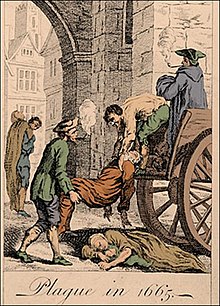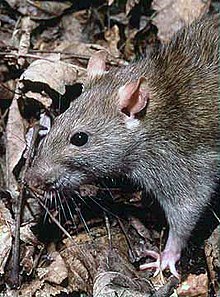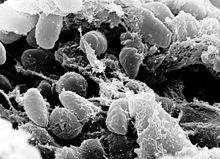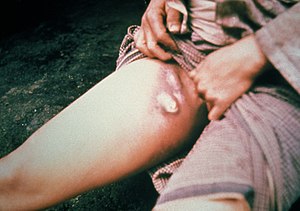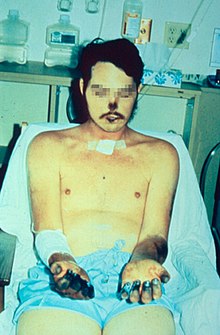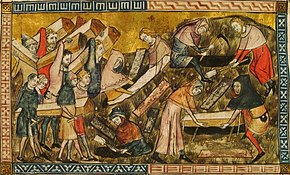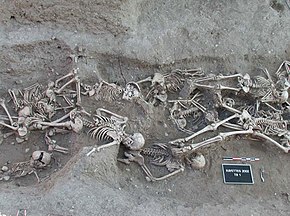Collecting the dead for burial during the Great Plague
The Great Plague, lasting from 1665 to 1666, was the last major epidemic of the bubonic plague to occur in England. It happened within the centuries-long time period of the Second Pandemic, an extended period of intermittent bubonic plague epidemics which originated in China in 1331, the first year of the Black Death, an outbreak which included other forms such as pneumonic plague, and lasted until 1750.
The Great Plague killed an estimated 100,000 people—almost a quarter of London's population—in 18 months. The plague was caused by the Yersinia pestis bacterium, which is usually transmitted through the bite of an infected rat flea.
The 1665–66 epidemic was on a far smaller scale than the earlier Black Death pandemic;
it was remembered afterwards as the "great" plague mainly because it
was the last widespread outbreak of bubonic plague in England during the
400-year timespan of the Second Pandemic.
London in 1665
Map of London by Wenceslas Hollar, c.1665
As in other European cities of the period, the plague was endemic in 17th century London.
The disease periodically erupted into massive epidemics. There were
30,000 deaths due to the plague in 1603, 35,000 in 1625, and 10,000 in
1636, as well as smaller numbers in other years.
During the winter of 1664, a bright comet was to be seen in the sky
and the people of London were fearful, wondering what evil event it
portended. London at that time consisted of a city of about 448 acres
surrounded by a city wall, which had originally been built to keep out raiding bands. There were gates at Ludgate, Newgate, Aldersgate, Cripplegate, Moorgate and Bishopsgate and to the south lay the River Thames and London Bridge.
In the poorer parts of the city, hygiene was impossible to maintain in
the overcrowded tenements and garrets. There was no sanitation, and open
drains flowed along the centre of winding streets. The cobbles were
slippery with animal dung, rubbish and the slops thrown out of the
houses, muddy and buzzing with flies in summer and awash with sewage in
winter. The City Corporation
employed "rakers" to remove the worst of the filth and it was
transported to mounds outside the walls where it accumulated and
continued to decompose. The stench was overwhelming and people walked
around with handkerchiefs or nosegays pressed against their nostrils.
Some of the city's necessities such as coal arrived by barge,
but most came by road. Carts, carriages, horses and pedestrians were
crowded together and the gateways in the wall formed bottlenecks through
which it was difficult to progress. The nineteen-arch London Bridge was
even more congested. The better-off used hackney carriages and sedan chairs
to get to their destinations without getting filthy. The poor walked,
and might be splashed by the wheeled vehicles and drenched by slops
being thrown out and water falling from the overhanging roofs. Another
hazard was the choking black smoke belching forth from factories which
made soap, from breweries and iron smelters and from about 15,000 houses burning coal.
Scenes in London during the plague of 1665
Outside the city walls, suburbs had sprung up providing homes for the
craftsmen and tradespeople who flocked to the already overcrowded city.
These were shanty towns
with wooden shacks and no sanitation. The government had tried to
control this development but had failed and over a quarter of a million
people lived here. Other immigrants had taken over fine town houses, vacated by Royalists who had fled the country during the Commonwealth,
converting them into tenements with different families in every room.
These properties were soon vandalised and became rat-infested slums.
The administration of the City of London was organised by the
Lord Mayor, Aldermen and common councillors, but not all of the
inhabited area generally comprising London was legally part of the City.
Both inside the City and outside its boundaries there were also Liberties,
which were areas of varying sizes which historically had been granted
rights to self-government. Many had been associated with religious
institutions, and when these were abolished in the Dissolution of the Monasteries,
their historic rights were transferred along with their property to new
owners. The walled City was surrounded by a ring of Liberties which had
come under its authority, contemporarily called 'the City and
Liberties', but these were surrounded by further suburbs with varying
administrations. Westminster was an independent town with its own liberties, although it was joined to London by urban development. The Tower of London
was an independent liberty, as were others. Areas north of the river
not part of one of these administrations came under the authority of the
county of Middlesex, and south of the river under Surrey.
The "Woodcut" map of London, dating from the 1560s
At that time, bubonic plague was a much feared disease but its cause
was not understood. The credulous blamed emanations from the earth,
"pestilential effluviums", unusual weather, sickness in livestock,
abnormal behaviour of animals or an increase in the numbers of moles,
frogs, mice or flies. It was not until 1894 that the identification by Alexandre Yersin of its causal agent Yersinia pestis was made and the transmission of the bacterium by rat fleas became known. Although the Great Plague in London had long been believed to be bubonic plague caused by Yersinia pestis, this was only definitively confirmed by DNA analysis in 2016.
The recording of deaths
In order to judge the severity of an epidemic, it is first necessary
to know how big the population was in which it occurred. There was no
official census of the population to provide this figure, and the best
contemporary count comes from the work of John Graunt (1620–1674), who was one of the earliest Fellows of the Royal Society and one of the first demographers,
bringing a scientific approach to the collection of statistics. In
1662, he estimated that 384,000 people lived in the City of London, the
Liberties, Westminster and the out-parishes, based on figures in the bills of mortality
published each week in the capital. These different districts with
different administrations constituted the officially recognized extent
of London as a whole. In 1665, he revised his estimate to 'not above
460,000'. Other contemporaries put the figure higher, (the French
Ambassador, for example, suggested 600,000) but with no mathematical
basis to support their estimates. The next largest city in the kingdom
was Norwich, with a population of 30,000.
There was no duty to report a death to anyone in authority. Instead, each parish appointed two or more 'searchers of the dead',
whose duty was to inspect a corpse and determine the cause of death. A
searcher was entitled to charge a small fee from relatives for each
death they reported, and so habitually the parish would appoint someone
to the post who would otherwise be destitute and would be receiving
support from the parish poor rate. Typically, this meant searchers would
be old women who were illiterate, might know little about identifying
diseases and who would be open to dishonesty. Searchers would typically learn about a death either from the local sexton
who had been asked to dig a grave or from the tolling of a church bell.
Anyone who did not report a death to their local church, such as Quakers, Anabaptists, other non-Anglican Christians or Jews,
frequently did not get included in the official records. Searchers
during times of plague were required to live apart from the community,
avoid other people and carry a white stick to warn of their occupation
when outdoors, and stay indoors except when performing their duties, to
avoid spreading the diseases. Searchers reported to the Parish Clerk,
who made a return each week to the Company of Parish Clerks in Brode
Lane. Figures were then passed to the Lord Mayor and then to the
Minister of State once plague became a matter of national concern. The reported figures were used to compile the Bills of Mortality,
which listed total deaths in each parish and whether by the plague. The
system of Searchers to report the cause of death continued until 1836.
Graunt recorded the incompetence of the Searchers at identifying
true causes of death, remarking on the frequent recording of
'consumption' rather than other diseases which were recognized then by
physicians. He suggested a cup of ale and a doubling of their fee to two
groats rather than one was sufficient for Searchers to change the cause
of death to one more convenient for the householders. No one wished to
be known as having had a death by plague in their household, and Parish
Clerks, too, connived in covering up cases of plague in their official
returns. Analysis of the Bills of Mortality during the months plague
took hold shows a rise in deaths other than by plague well above the
average death rate, which has been attributed to misrepresentation of
the true cause of death. As plague spread, a system of quarantine
was introduced, whereby any house where someone had died from plague
would be locked up and no one allowed to enter or leave for 40 days.
This frequently led to the deaths of the other inhabitants, by neglect
if not from the plague, and provided ample incentive not to report the
disease. The official returns record 68,596 cases of plague, but a
reasonable estimate suggests this figure is 30,000 short of the true
total. A plague house was marked with a red cross on the door with the words "Lord have mercy upon us", and a watchman stood guard outside.
Preventive measures
Reports
of plague around Europe began to reach England in the 1660s, causing
the Privy Council to consider what steps might be taken to prevent it
crossing to England. Quarantining of ships had been used during previous
outbreaks and was again introduced for ships coming to London in
November 1663, following outbreaks in Amsterdam and Hamburg.
Two naval ships were assigned to intercept any vessels entering the
Thames estuary. Ships from infected ports were required to moor at Hole
Haven on Canvey Island
for a period of 30 days before being allowed to travel upriver. Ships
from ports free of plague or completing their quarantine were given a
certificate of health and allowed to travel on. A second inspection
line was established between the forts on opposite banks of the Thames
at Tilbury and Gravesend with instructions only to pass ships with a certificate.
The quarantine duration was increased to forty days in May 1664
as the continental plague worsened, and the areas subject to quarantine
changed with the news of the spread of plague to include all of Holland, Zeeland and Friesland (all regions of the Dutch Republic),
although restrictions on Hamburg were removed in November. Quarantine
measures against ships coming from the Dutch Republic were put in place
in 29 other ports from May, commencing with Great Yarmouth.
The Dutch ambassador objected at the constraint of trade with his
country, but England responded that it had been one of the last
countries introducing such restrictions. Regulations were enforced quite
strictly, so that people or houses where voyagers had come ashore
without serving their quarantine were also subjected to 40 days of
quarantine.
Outbreak
Plague was one of the hazards of life in Britain from its dramatic
appearance in 1348 with the Black Death. The Bills of Mortality began to
be published regularly in 1603, in which year 33,347 deaths were
recorded from plague. Between then and 1665, only four years had no
recorded cases. In 1563, a thousand people were reportedly dying in
London each week. In 1593, there were 15,003 deaths, 1625 saw 41,313
dead, between 1640 and 1646 came 11,000 deaths, culminating in 3,597
for 1647. The 1625 outbreak was recorded at the time as the 'Great
Plague', until deaths from the plague of 1665 surpassed it. These
official figures are likely to under-report actual numbers.
Early days
Rattus rattus,
the Black Rat. Smaller than the Norwegian rat, which later supplanted
it, it is also keener to live near to humankind. Timber houses and
overcrowded slums provided great homes. The link between the rat as
reservoir of infection and host to fleas which could transfer to man was
not understood. Efforts were made to eliminate cats and dogs but not
rats. If anything, this encouraged the rats.
Although plague was known, it was still sufficiently uncommon that
medical practitioners might have had no personal experience of seeing
the disease; medical training varied from those who had attended the
college of physicians, to apothecaries who also acted as modern doctors,
to simple charlatans. Other diseases abounded, such as an outbreak of
smallpox the year before, and these uncertainties all added to
difficulties identifying the true start of the epidemic.
Contemporary accounts suggest cases of plague occurred through the
winter of 1664/5, some of which were fatal but a number of which did not
display the virulence of the later epidemic. The winter was cold, the
ground frozen from December to March, river traffic on the Thames twice
blocked by ice, and it may be that the cold weather held back its
spread.
This outbreak of bubonic plague in England is thought to have spread from the Netherlands,
where the disease had been occurring intermittently since 1599. It is
unclear exactly where the disease first struck but the initial contagion
may have arrived with Dutch trading ships carrying bales of cotton from Amsterdam, which was ravaged by the disease in 1663–1664, with a mortality given of 50,000. The first areas to be struck are believed to be the dock areas just outside London, and the parish of St Giles.
In both of these localities, poor workers were crowded into ill-kept
structures. Two suspicious deaths were recorded in St. Giles parish in 1664 and another in February 1665. These did not appear as plague deaths on the Bills of Mortality,
so no control measures were taken by the authorities, but the total
number of people dying in London during the first four months of 1665
showed a marked increase. By the end of April, only four plague deaths
had been recorded, two in the parish of St. Giles, but total deaths per
week had risen from around 290 to 398.
Although there had been only three official cases in April, which
level of plague in earlier years had not induced any official response,
the Privy Council now acted to introduce household quarantine. Justices
of the Peace in Middlesex were instructed to investigate any suspected
cases and to shut up the house if it was confirmed. Shortly after, a
similar order was issued by the King's Bench to the City and Liberties. A
riot broke out in St. Giles when the first house was sealed up; the
crowd broke down the door and released the inhabitants. Rioters caught
were punished severely. Instructions were given to build pest-houses,
which were essentially isolation hospitals built away from other people
where the sick could be cared for (or stay until they died). This
official activity suggests that despite the few recorded cases, the
government was already aware that this was a serious outbreak of plague.
With the arrival of warmer weather, the disease began to take a
firmer hold. In the week 2–9 May, there were three recorded deaths in
the parish of St Giles, four in neighbouring St Clement Danes and one each in St Andrew Holborn and St Mary Woolchurch Haw.
Only the last was actually inside the city walls. A Privy Council
committee was formed to investigate methods to best prevent the spread
of plague, and measures were introduced to close some of the ale houses
in affected areas and limit the number of lodgers allowed in a
household. In the city, the Lord Mayor issued a proclamation that all
householders must diligently clean the streets outside their property,
which was a householder's responsibility, not a state one (the city
employed scavengers and rakers to remove the worst of the mess). Matters
just became worse, and Aldermen were instructed to find and punish
those failing their duty.
As cases in St. Giles began to rise, an attempt was made to quarantine
the area and constables were instructed to inspect everyone wishing to
travel and contain inside vagrants or suspect persons.
People began to be alarmed. Samuel Pepys, who had an important position at the Admiralty, stayed in London and provided a contemporary account of the plague through his diary.
On 30 April he wrote: "Great fears of the sickness here in the City it
being said that two or three houses are already shut up. God preserve us
all!" Another source of information on the time is A Journal of the Plague Year, which was written by Daniel Defoe
and published in 1722. He had been only six when the plague struck but
made use of his family's recollections (his uncle was a saddler in East
London and his father a butcher in Cripplegate), interviews with survivors and sight of such official records as were available.
Exodus from the city
By July 1665, plague was rampant in the City of London. The rich ran away, including King Charles II of England, his family and his court, who left the city for Salisbury, moving on to Oxford in September when some cases of plague occurred in Salisbury. The aldermen and most of the other city authorities opted to stay at their posts. The Lord Mayor of London, Sir John Lawrence,
also decided to stay in the city. Businesses were closed when merchants
and professionals fled. Defoe wrote "Nothing was to be seen but wagons
and carts, with goods, women, servants, children, coaches filled with
people of the better sort, and horsemen attending them, and all hurrying
away". As the plague raged throughout the summer, only a small number of clergymen, physicians and apothecaries remained to cope with an increasingly large number of victims. Edward Cotes, author of London's Dreadful Visitation, expressed the hope that "Neither the Physicians of our Souls or Bodies may hereafter in such great numbers forsake us".
The poorer people were also alarmed by the contagion and some
left the city, but it was not easy for them to abandon their
accommodation and livelihoods for an uncertain future elsewhere. Before
exiting through the city gates, they were required to possess a
certificate of good health signed by the Lord Mayor and these became
increasingly difficult to obtain. As time went by and the numbers of
plague victims rose, people living in the villages outside London began
to resent this exodus and were no longer prepared to accept townsfolk
from London, with or without a certificate. The refugees were turned
back, were not allowed to pass through towns and had to travel across
country, and were forced to live rough on what they could steal or
scavenge from the fields. Many died in wretched circumstances of
starvation and thirst in the hot summer that was to follow.
Height of the epidemic
A bill of mortality for the plague in 1665
In the last week of July, the London Bill of Mortality showed 3,014
deaths, of which 2,020 had died from the plague. The number of deaths as
a result of plague may have been underestimated, as deaths in other
years in the same period were much lower, at around 300. As the number
of victims affected mounted up, burial grounds became overfull, and pits
were dug to accommodate the dead. Drivers of dead-carts travelled the
streets calling "Bring out your dead" and carted away piles of bodies.
The authorities became concerned that the number of deaths might cause
public alarm and ordered that body removal and interment should take
place only at night.
As time went on, there were too many victims, and too few drivers, to
remove the bodies which began to be stacked up against the walls of
houses. Daytime collection was resumed and the plague pits became mounds
of decomposing corpses. In the parish of Aldgate, a great hole was dug
near the churchyard, fifty feet long and twenty feet wide. Digging was
continued by labourers at one end while the dead-carts tipped in corpses
at the other. When there was no room for further extension it was dug
deeper until ground water was reached at twenty feet. When finally
covered with earth it housed 1,114 corpses.
Plague doctors traversed the streets diagnosing victims, although many of them had no formal medical training. Several public health
efforts were attempted. Physicians were hired by city officials and
burial details were carefully organized, but panic spread through the
city and, out of the fear of contagion, people were hastily buried in
overcrowded pits. The means of transmission of the disease were not
known but thinking they might be linked to the animals, the City
Corporation ordered a cull of dogs and cats.
This decision may have affected the length of the epidemic since those
animals could have helped keep in check the rat population carrying the
fleas which transmitted the disease. Thinking bad air was involved in
transmission, the authorities ordered giant bonfires to be burned in the
streets and house fires to be kept burning night and day, in hopes that
the air would be cleansed. Tobacco was thought to be a prophylactic and it was later said that no London tobacconist had died from the plague during the epidemic.
Trade and business had completely dried up, and the streets were
empty of people except for the dead-carts and the desperate dying
victims, as witnessed and recorded by Samuel Pepys in his diary: "Lord!
How empty the streets are and how melancholy, so many poor sick people
in the streets full of sores… in Westminster, there is never a physician
and but one apothecary left, all being dead." That people did not starve was down to the foresight of Sir John Lawrence and the Corporation of London who arranged for a commission of one farthing to be paid above the normal price for every quarter of corn landed in the Port of London.
Another food source was the villages around London which, denied of
their usual sales in the capital, left vegetables in specified market
areas, negotiated their sale by shouting, and collected their payment
after the money had been left submerged in a bucket of water to
"disinfect" the coins.
Records state that plague deaths in London and the suburbs crept
up over the summer from 2,000 people per week to over 7,000 per week in
September. These figures are likely to be a considerable underestimate.
Many of the sextons and parish clerks who kept the records themselves
died. Quakers
refused to co-operate and many of the poor were just dumped into mass
graves unrecorded. It is not clear how many people caught the disease
and made a recovery because only deaths were recorded and many records
were destroyed in the Great Fire of London
the following year. In the few districts where intact records remain,
plague deaths varied between 30% and over 50% of the total population.
Although concentrated in London, the outbreak affected other
areas of the country as well. Perhaps the most famous example was the
village of Eyam in Derbyshire.
The plague allegedly arrived with a merchant carrying a parcel of cloth
sent from London, although this is a disputed point. The villagers
imposed a quarantine on themselves to stop the further spread of the
disease. This prevented the disease from moving into surrounding areas,
but around 33% of the village's inhabitants died over a period of
fourteen months.
Aftermath
By late autumn, the death toll in London and the suburbs began to
slow until, in February 1666, it was considered safe enough for the King
and his entourage to come back to the city. With the return of the
monarch, others began to return: The gentry returned in their carriages
accompanied by carts piled high with their belongings. The judges moved
back from Windsor to sit in Westminster Hall, although Parliament, which had been prorogued
in April 1665, did not reconvene until September 1666. Trade
recommenced and businesses and workshops opened up. London was the goal
of a new wave of people who flocked to the city in expectation of making
their fortunes. Writing at the end of March 1666, Lord Clarendon, the Lord Chancellor,
stated "... the streets were as full, the Exchange as much crowded, the
people in all places as numerous as they had ever been seen ...".
Plague cases continued to occur sporadically at a modest rate
until the summer of 1666. On the second and third of September that
year, the Great Fire of London
destroyed much of the City of London, and some people believed that the
fire put an end to the epidemic. However, it is now thought that the
plague had largely subsided before the fire took place. In fact, most of
the later cases of plague were found in the suburbs, and it was the City of London itself that was destroyed by the Fire.
According to the Bills of Mortality, there were in total 68,596
deaths in London from the plague in 1665. Lord Clarendon estimated that
the true number of mortalities was probably twice that figure. The next
year, 1666, saw further deaths in other cities but on a lesser scale. Dr Thomas Gumble, chaplain to the Duke of Albemarle,
both of whom had stayed in London for the whole of the epidemic,
estimated that the total death count for the country from plague during
1665 and 1666 was about 200,000.
The Great Plague of 1665/1666 was the last major outbreak of bubonic plague
in Great Britain. The last recorded death from plague came in 1679, and
it was removed as a specific category in the Bills of Mortality after
1703. It spread to other towns in East Anglia and the southeast of
England but fewer than ten percent of parishes outside London had a
higher than average death rate during those years. Urban areas were more
affected than rural ones; Norwich, Ipswich, Colchester, Southampton and
Winchester were badly affected, while the West of England and areas of
the Midlands escaped altogether.
The population of England in 1650 was approximately 5.25 million,
which declined to about 4.9 million by 1680, recovering to just over 5
million by 1700. Other diseases, such as smallpox, took a high toll on
the population even without the contribution by plague. The higher death
rate in cities, both generally and specifically from the plague, was
made up by continuous immigration, from small towns to larger ones and
from the countryside to the town.
There were no contemporary censuses of London's population, but
available records suggest that the population returned to its previous
level within a couple of years. Burials in 1667 had returned to 1663
levels, Hearth Tax returns had recovered, John Graunt contemporarily
analysed baptism records and concluded they represented a recovered
population. Part of this could be accounted for by the return of wealthy
households, merchants and manufacturing industries, all of which needed
to replace losses among their staff and took steps to bring in
necessary people. Colchester had suffered more severe depopulation, but
manufacturing records for cloth suggested that production had recovered
or even increased by 1669, and the total population had nearly returned
to pre-plague levels by 1674. Other towns did less well: Ipswich was
affected less than Colchester, but in 1674, its population had dropped
by 18%, more than could be accounted for by the plague deaths alone.
As a proportion of the population who died, the London death toll
was less severe than in a number of other towns. The total of deaths in
London was greater than in any previous outbreak for 100 years, though
as a proportion of the population, the epidemics in 1563, 1603 and 1625
were comparable or greater. Perhaps around 2.5% of the English
population died.
Impact
The
plague in London largely affected the poor, as the rich were able to
leave the city by either retiring to their country estates or residing
with kin in other parts of the country. The subsequent Great Fire of London, however, ruined many city merchants and property owners. As a result of these events, London was largely rebuilt and Parliament enacted the Rebuilding of London Act 1666.
Although the street plan of the capital remained relatively unchanged,
some improvements were made: streets were widened, pavements were
created, open sewers abolished, wooden buildings and overhanging gables
forbidden, and the design and construction of buildings controlled. The
use of brick or stone was mandatory and many gracious buildings were
constructed. Not only was the capital rejuvenated, but it became a
healthier environment in which to live. Londoners had a greater sense of
community after they had overcome the great adversities of 1665 and
1666.
Rebuilding took over ten years and was supervised by Robert Hooke as Surveyor of London. The architect Sir Christopher Wren was involved in the rebuilding of St Paul's Cathedral and more than fifty London churches. King Charles ll did much to foster the rebuilding work. He was a patron of the arts and sciences and founded the Royal Observatory and supported the Royal Society, a scientific group whose early members included Robert Hooke, Robert Boyle and Sir Isaac Newton. In fact, out of the fire and pestilence flowed a renaissance in the arts and sciences in England.
Plague pits have been archaeologically excavated during underground construction work. Between 2011 and 2015, some 3,500 burials from the 'New Churchyard' or 'Bethlam burial ground' were discovered during the construction of the Crossrail railway at Liverpool Street. Yersinia pestis DNA was found in the teeth of individuals found buried in pits at the site, confirming they had died of bubonic plague.
